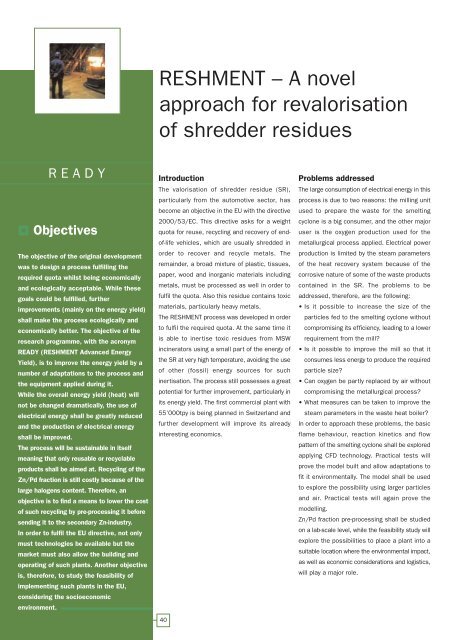European Bio-Energy Projects
European Bio-Energy Projects
European Bio-Energy Projects
Create successful ePaper yourself
Turn your PDF publications into a flip-book with our unique Google optimized e-Paper software.
READY<br />
Objectives<br />
The objective of the original development<br />
was to design a process fulfilling the<br />
required quota whilst being economically<br />
and ecologically acceptable. While these<br />
goals could be fulfilled, further<br />
improvements (mainly on the energy yield)<br />
shall make the process ecologically and<br />
economically better. The objective of the<br />
research programme, with the acronym<br />
READY (RESHMENT Advanced <strong>Energy</strong><br />
Yield), is to improve the energy yield by a<br />
number of adaptations to the process and<br />
the equipment applied during it.<br />
While the overall energy yield (heat) will<br />
not be changed dramatically, the use of<br />
electrical energy shall be greatly reduced<br />
and the production of electrical energy<br />
shall be improved.<br />
The process will be sustainable in itself<br />
meaning that only reusable or recyclable<br />
products shall be aimed at. Recycling of the<br />
Zn/Pd fraction is still costly because of the<br />
large halogens content. Therefore, an<br />
objective is to find a means to lower the cost<br />
of such recycling by pre-processing it before<br />
sending it to the secondary Zn-industry.<br />
In order to fulfil the EU directive, not only<br />
must technologies be available but the<br />
market must also allow the building and<br />
operating of such plants. Another objective<br />
is, therefore, to study the feasibility of<br />
implementing such plants in the EU,<br />
considering the socioeconomic<br />
environment.<br />
RESHMENT – A novel<br />
approach for revalorisation<br />
of shredder residues<br />
Introduction<br />
The valorisation of shredder residue (SR),<br />
particularly from the automotive sector, has<br />
become an objective in the EU with the directive<br />
2000/53/EC. This directive asks for a weight<br />
quota for reuse, recycling and recovery of endof-life<br />
vehicles, which are usually shredded in<br />
order to recover and recycle metals. The<br />
remainder, a broad mixture of plastic, tissues,<br />
paper, wood and inorganic materials including<br />
metals, must be processed as well in order to<br />
fulfil the quota. Also this residue contains toxic<br />
materials, particularly heavy metals.<br />
The RESHMENT process was developed in order<br />
to fulfil the required quota. At the same time it<br />
is able to inertise toxic residues from MSW<br />
incinerators using a small part of the energy of<br />
the SR at very high temperature, avoiding the use<br />
of other (fossil) energy sources for such<br />
inertisation. The process still possesses a great<br />
potential for further improvement, particularly in<br />
its energy yield. The first commercial plant with<br />
55’000tpy is being planned in Switzerland and<br />
further development will improve its already<br />
interesting economics.<br />
40<br />
Problems addressed<br />
The large consumption of electrical energy in this<br />
process is due to two reasons: the milling unit<br />
used to prepare the waste for the smelting<br />
cyclone is a big consumer, and the other major<br />
user is the oxygen production used for the<br />
metallurgical process applied. Electrical power<br />
production is limited by the steam parameters<br />
of the heat recovery system because of the<br />
corrosive nature of some of the waste products<br />
contained in the SR. The problems to be<br />
addressed, therefore, are the following:<br />
• Is it possible to increase the size of the<br />
particles fed to the smelting cyclone without<br />
compromising its efficiency, leading to a lower<br />
requirement from the mill?<br />
• Is it possible to improve the mill so that it<br />
consumes less energy to produce the required<br />
particle size?<br />
• Can oxygen be partly replaced by air without<br />
compromising the metallurgical process?<br />
• What measures can be taken to improve the<br />
steam parameters in the waste heat boiler?<br />
In order to approach these problems, the basic<br />
flame behaviour, reaction kinetics and flow<br />
pattern of the smelting cyclone shall be explored<br />
applying CFD technology. Practical tests will<br />
prove the model built and allow adaptations to<br />
fit it environmentally. The model shall be used<br />
to explore the possibility using larger particles<br />
and air. Practical tests will again prove the<br />
modelling.<br />
Zn/Pd fraction pre-processing shall be studied<br />
on a lab-scale level, while the feasibility study will<br />
explore the possibilities to place a plant into a<br />
suitable location where the environmental impact,<br />
as well as economic considerations and logistics,<br />
will play a major role.

















